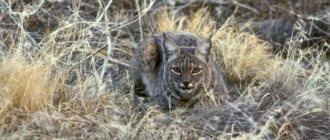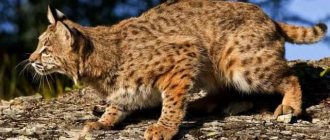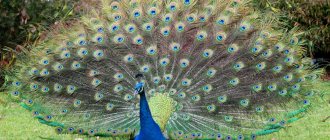Lynx: general characteristics
These animals belong to the class of predatory mammals and represent the only genus of lynx, which includes 4 species. Lynxes are part of the subfamily of small cats, and are considered close relatives of cheetahs, pumas, and all other representatives of the wild cat tribe.
Lynxes are beautiful and graceful cats
Lynxes are small in size, their height does not exceed 70 cm, and their weight, depending on the subspecies, varies between 6-30 kg. Forest predators have a short powerful body, long and muscular limbs. The coat of animals is thick and fluffy, with dense undercoat. The usual color of lynxes is sandy-red; dark spots are scattered throughout the body, which merge into a bizarre pattern. One of the distinctive features of the animals is their short, stubby tail, the tip of which is always black (in red lynxes it is white).
The soles of these cats' paws are also covered with thick fur, which makes the lynx's tread light and silent, and also allows them to move deftly through the snow without falling into deep snowdrifts.
These cats cannot boast of endurance, and at a fast pace they can cover no more than 100 meters. But they jump well, which they use when hunting as their main advantage. Lynxes also skillfully climb trees and swim beautifully.
In the wild, their life expectancy is 15-20; in captivity they can reach 25 years of age.
Elena
Ask a Question
Question to the expert
Why do lynxes have tassels on their ears?
The fluffy tassels at the tips of the ears of these beautiful predators have long become their calling card. But this is not just a decoration, but an important attribute that acts as a natural resonator, capturing the slightest sound vibrations in the air. During the experiment, scientists cut off several cats' tassels, and the animals' hearing decreased by half; they immediately began to feel insecure and poorly oriented in space.
Reproduction and lifespan
The rut begins in February and ends in March. Several males can follow one female at the same time, during which fights often arise between them, accompanied by loud hissing and screams that carry over a long distance.
Gestation time is about 2 months. Cubs are born in April-May. The number of kittens is usually 2 - 3, but sometimes even 4 or 5 can be born. The average weight of newborns is 300 grams. Like the rest of the cat family, they are blind for the first 2 weeks, then open their eyes.
The female is the only one responsible for rearing. For the first 2 months of life, kittens feed on milk, after which they switch to animal food. Sexual maturity of females occurs after 1 year, males - 2 years. In the taiga, the lynx lives on average from 15 to 20 years. If a cat is kept in captivity, then with proper care it can live more than 25 years.
Natural habitat
In the wild, lynxes are found only on two continents - Eurasia and North America. These animals are the northernmost species of cats, and are found even beyond the Arctic Circle.
The lynx family was once found throughout Europe but was extirpated from the western and central parts of the continent, and efforts are now being made to reintroduce the spotted beasts to countries such as Germany, France and Switzerland.
In the wild, lynxes inhabit the following regions:
- Russia, including the Far Eastern Kamchatka Peninsula and Sakhalin Island;
- Ukraine, including the Chernobyl zone;
- Poland;
- Belarus;
- Carpathian mountain range from the Czech Republic to Romania;
- Scandinavian Peninsula;
- Baltic countries;
- Balkan Peninsula;
- Transcaucasia: Armenia, Georgia, Azerbaijan;
- Central Asia: Tajikistan, Kyrgyzstan, Turkmenistan, Uzbekistan, Kazakhstan;
- China;
- Mongolia;
- Alaska;
- Canada;
- USA;
- Mexico.
Spotted cats prefer to settle in dense taiga and coniferous forests; they also like high mountain areas. Lynxes also wander into the forest-tundra, because thanks to their thick fur, they feel great among the polar snows. They can also live in steppe regions, choosing rough places with bushes.
Leather
The skin of a wild cat consists of epidermis and dermis and has the unique ability to be mobile. This property is invaluable during predator fights or in the fight against prey. The skin is supplied with nerve fibers, blood vessels and is densely covered with hair. A hair follicle can accommodate up to 5-6 axial hairs, which, in turn, are surrounded by downy hairs. The muscles located in each follicle raise and lower the fur during fear or anxiety, as well as in cold weather, helping to reduce heat loss.
The skin of a lynx not only protects it from the cold, but also protects it from sunburn, as well as from all kinds of damage.
The predator's fur is very thick and warm, unrivaled among felines. At the same time, it is heterogeneous - shorter on the back, long on the belly, silky, often white. Lynx skin is extremely valued and in demand along with the fur of fur-bearing animals.
Having examined the structure of the predator and some structural features of its body, it is obvious that the anatomy of the lynx and the physiology of this mammal is characterized by the presence of more advanced functional systems than other representatives of the vertebrate class.
What do lynxes eat in the wild?
Lynxes belong to the category of carnivores, so it is natural that their menu consists of meat. The diet of these beautiful cats depends on their habitat, and they mainly hunt hares, small rodents and game birds. Their list of victims also includes larger prey in the form of artiodactyls and wild boars. Lynxes also attack fur-bearing animals, and even without being hungry, they often kill martens and foxes, for which for some reason they have a special dislike.
This lynx will have a hearty dinner today
Unlike most predators, furry cats do not diversify their menu with plant foods; they do not like young shoots of cereals and wild berries. Lynxes disdain carrion, and can eat the decaying corpse of an animal only in the event of a catastrophic lack of food.
Lynxes need 2 kg of meat per day, so a large hare lasts them 2-3 days. And near the carcass of a roe deer or wild boar, forest beauties can feast for a week, of course, if another predator does not take away their prey. Sometimes cats make pantries, burying the remains of their meals under the snow or soil. But lynxes act in a hurry, so it is not difficult for stoats, foxes and sables to ruin their supplies.
Who do lynxes hunt?
As soon as night begins to fall on the ground, small forest inhabitants rush to take refuge in their holes. After all, with the onset of dusk, the lynx goes out hunting, looking for a suitable dinner for itself.
The objects of lynx hunting are:
- Hares, wild rabbits;
- Small rodents: gophers, jerboas, hamsters, voles;
- Feathered game - black grouse, wood grouse, quail, hazel grouse;
- Beavers, martens;
- Raccoon dogs;
- Proteins;
- Badgers;
- Ferrets, weasels;
- Wild boars;
- Small ungulates, such as roe deer and Siberian musk deer.
These cats also attack large herbivores such as moose and deer. True, they rarely manage to kill adult animals, and often the predators’ evening meal includes cubs, as well as old or sick individuals.
Lynxes will never refuse to feast on fresh fish, and they manage to catch fish no worse than hares and rodents. Spotted cats, like real fishermen, sit for a long time on the shore, and at the sight of flashing scales, they instantly snatch the fish out of the water. And if necessary, the lynx will go after its catch into the river, because they are not afraid of water, and are generally excellent swimmers.
Reproduction and raising of offspring
Reproductive age in lynxes occurs when they reach 2 years of age. Females are ready to bear offspring at 22-24 months of life, males mature later, and are capable of reproduction when they are 2.5 years old.
The mating season for lynxes occurs only once a year; their rut begins in February and ends with the arrival of April.
Mating season
The entire forest district knows that lynxes have begun mating. Usually these cats are quiet and silent, which is natural, because they do not need to give themselves away with unnecessary sounds while hunting or when encountering other predators. But during the breeding season, spotted animals forget about caution and announce the surroundings with growls, meows and prolonged howls.
A couple of lynxes in love
One spotted lady is courted by several males at once. They behave exactly like March cats: they scream, howl and delight the ears of females with romantic “serenades”. And of course, it doesn’t happen without fights. Excited gentlemen find out which of them is most worthy to mate with the female in a fair duel.
First, males try to intimidate their opponents by hissing and hoarse meows. If the competitor is not impressed, then a fight cannot be avoided, during which the lynxes, without a twinge of conscience, use all the weapons available to them, that is, teeth and claws. Their battles do not lead to deaths, but after them the males remain with battle marks and scars.
The winner proudly leaves with his chosen one, and the loving couple spends about a week together. The relationship between them is very warm and reverent, the lynxes gently butt their foreheads, rub their noses, as if kissing, and affectionately lick each other’s fur as a sign of affection. During the time spent together, the couple mates several times, and at this point their marriage is considered dissolved, so they go in different directions, and most likely will never meet again.
During the mating season, females enter into sexual relations with only one partner, and the males adhere to polygamous views, and after parting with their chosen one, they go in search of another lady of their heart.
Duration of pregnancy and childbirth
Female lynx bear their offspring for 62-70 days, and their total gestation period is just over 2 months. A couple of weeks before giving birth, the expectant mother begins to search for a suitable shelter, choosing the most remote and difficult places. They usually build a brood nest in earthen caves or among windbreaks, where the lair will be hidden from prying eyes by upturned tree trunks.
Newborn lynx babies
Females understand that the shelter for raising offspring must be warm and cozy, so they carefully line its bottom with bird feathers, dry grass and the soft hair of fur-bearing animals.
In one lynx litter, only 1-3 babies are born; in very rare cases, a litter consists of 4-5 lynx cubs. Like all kittens, lynx cubs are born blind and deaf, and their weight does not exceed 250-300 g. Babies develop quickly, already at 1 week their fur becomes longer and fluffier, and their eyes open on the 12th day of life. By the way, newborn lynx cubs do not look at all like their parents; their irises are bright blue, and their fur has a reddish-brown tint. Only by the age of one and a half years will they acquire the appearance of adults, acquiring a characteristic color and tassels on their ears.
Caring for the Cubs
Lynxes are extremely responsible and caring mothers. The first month after birth, they leave the cubs only for a couple of hours, and hunt near the den, so that in case of danger they quickly return back. Females gently lick their babies, and also vigilantly monitor the cleanliness of the shelter, clearing it of debris and removing waste from the kittens.
If a lynx discovers other animals near the shelter, it immediately moves its descendants to a safer place. And of course, if attacked by a predator, the female will fight to the last for the life of her cubs.
Spotted kittens feed on their mother's milk for 1 month, after which the mother begins to accustom them to solid food. First, the female feeds the babies with fresh pieces of meat, and when they reach 2 months of age, she brings them half-dead small prey in the form of hamsters and mice. So lynx cubs early learn the wisdom of hunting and getting their own food, because soon they will have to learn to survive alone.
Young lynx cubs receive survival lessons from their mother
About 3 months after giving birth, the lynx finally brings its heirs into the wide and beautiful world. During this time, the kids have already become quite strong and can follow their mother, simultaneously gaining hunting knowledge. Young lynx cubs learn to climb trees, swim and track prey, in general, useful skills that will be useful to them in adulthood.
The cubs remain near the mother until the next mating season, with the onset of which she drives away the previous offspring. But, if for some reason the lynx failed to become pregnant again, then the entire next year their family will stay together. True, such cases are rare in the wild, and usually lynx cubs at one year of age already begin a solitary and dangerous independent life.
Question to an expert Can lynxes purr? Yes, lynxes purr like domestic cats. Well-fed predators love to stretch, sharpen their claws on trees and purr with satisfaction at the same time. And mother lynxes often sing a purring lullaby to their babies, which has a calming effect on them and makes them feel safe.
Natural enemies of the lynx
The life of these cats in the wild certainly cannot be called peaceful and serene. After all, furry beauties have to share territory with many formidable predators, who not only deprive them of their legitimate prey, but also, if possible, try to deal with such a strong competitor.
It is better for lynxes not to meet with a wolf pack
Among the representatives of the animal kingdom, the main enemies of the lynx are wolves. Moreover, for inexplicable reasons, they simply hate each other, and their confrontation has been going on since time immemorial. What’s interesting is that gray animals are well aware that they definitely cannot survive in a single fight against a lynx. But if a cat’s path is blocked by a whole pack of wolves, then its only chance of salvation is to take refuge in the nearest tree, otherwise the hungry pack will tear its sworn enemy to shreds.
Their closest relatives from the cat tribe also pose a considerable danger to lynxes. Snow leopards and Amur tigers live next to the Eurasian lynx, and the Canadian variety has such a large and ruthless predator as the puma as neighbors. None of them conduct a targeted hunt for the spotted cat, but they often leave the lynx hungry, taking away its hunting trophy.
The enmity between lynxes and wolverines has lasted for many centuries.
Among the natural enemies of lynxes are wolverines. These evil animals often follow spotted predators, and as soon as the cat gets food for itself, they immediately try to take away someone else's prey. And although wolverines are inferior in size to lynxes, they are equal in strength, moreover, the fight between them often ends in the death of the furry beauties.
But over their centuries-old history, lynxes have adapted to survive alongside large predators, and they have many ways in their arsenal to avoid the sharp teeth and claws of their formidable four-legged neighbors. But spotted cats rarely manage to survive after meeting people. While a lynx can still hide in a tree from hound dogs, dense foliage does not protect you from a hunting rifle. Therefore, the most important and terrible enemy of the lynx has always been and remains man, through whose fault these magnificent creatures are steadily approaching the point of extinction.
Description
Of the four species of lynx, Eurasian lynxes are the largest. They are also considered one of the largest predators in Europe, after brown bears and gray wolves. Body weight ranges from 18 to 36 kg, and length - from 70 to 130 cm. Height at the withers ranges from 60 to 65 cm. Sexual dimorphism is present, males are larger and stronger.
The coat is grey, red or yellow. There are three types of patterns: spotted, striped and solid. Large spots, small spots and rosettes may be present on the animal's body. Drawings depend on the habitat. The belly, front of the neck, inside of the paws, and ears are white. The tail is short, with a hard black tip. Eurasian lynxes have long paws, sharp and retractable claws, a round muzzle, and triangular ears. Characteristic features of the common lynx: black tufts at the ends of the ears and noticeably elongated “whiskers”. The paws are large and covered with hair, which helps them move through deep snow.
Kinds
There are several types of lynx, below we will describe them in more detail.
Common lynx
The most common representative of this species, everything that we wrote above, is primarily swayed by the common lynx.
Canadian
Some zoologists consider it a subspecies of the common lynx. As the name suggests, this lynx lives mainly in Canada, but it can also be found in a number of northern US states (Idaho, Montana). It also differs from the ordinary lynx in being half the size; its body length is 48-56 cm. The fur of the Canadian lynx is grayish-brown in color.
Pyrenean
This type of lynx is found in the southwest of Spain, nowadays mainly only in the territory of the Coto Doñana National Park and is the rarest in nature. If the lynx as an entire species is listed in the Red Book, as it is endangered, then the Iberian lynx is currently one of the rarest mammals on planet Earth - according to zoologists, its population is currently only There are only about 100 individuals, and all measures must be taken to preserve the Iberian lynx in the future.
In appearance, the Iberian lynx differs from the usual one in that it has a lighter coat color and the presence of pronounced spots, which gives it a resemblance to a leopard.
Redhead
Living in the United States, the red lynx is distinguished by its red-brown color, with gray shades, and the presence of a white mark on the inside of the tip of the tail (other lynxes have black). It is also smaller in size compared to the common lynx; the weight of the red lynx is 6-11 kg. And what’s most interesting is that among red lynxes there are sometimes melanists, that is, representatives with a completely black color, which, like representatives of melanistic jaguars and melanistic leopards, are called panthers.











